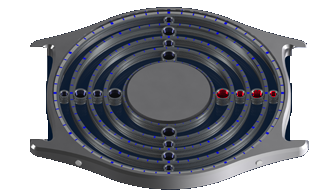Quartz-Mechanical watch generally is comprised of: case, glass(es), battery, quartz oscillator, stabilization system, buttons, controller, stepping motor and the movement. Using as the movement planetary gear assembly by leaving it visible from double sides, in its center naturally is placed the barrel with removing lid for the battery replacement. As the motor in quartz watches is engaged to the top gear, it is set in the case and drives outside ring gear. Also in the case is installed the buttons and others electronic modules.
As could be seen the mechanism of this chronograph is almost flat, therefore having realized function of its reverse drive, it can be used from both sides: as a variety of indications as the countdown timer, using for the time installation the increased speed of the driver.
Chronograph parameters:
| Diameter of the case, mm | 30 |
| Height of the case, mm | 2.4 |
| Diameter of the mechanism, mm | 27.5 |
| Height of the mechanism, mm | 1.4 |
| Possibilities | Second’s fractions, seconds, minutes, hours, week days, duoface, waterproof |
| Timekeeping element | Quartz-resonator (E9WS) |
| Energy source | Battery (SR69) |
| Minimal gear diameter, mm | 1.5 |
| Power reserve | 2 years |
| Way of battery replacement | Movable cover on the barrel in the watch center |
| Time setting way | Buttons on the case, increased speed of the reversible driver |
The rendering and disassembling movie of the Quartz-Mechanical watch.
One minutes movement with the full gearing engagement.

Fig.1

Fig.2
Description:
Based on the Fig.1, 2, the movement consists of 4 double rows planetary gearings with four satellites on each of them. The parameters of gears are selected to realize:
1) the orbital satellites 22 speed 1 rotation/week and 7 rotations/week about satellite’s axis;
2) the orbital satellites 19 speed 2 rotations/day and 24 rotations/day about satellite’s axis;
3) the orbital satellites 16 speed 1 rotation/hour and 12 rotations/hour about satellite’s axis;
4) the orbital satellites 13 speed 1 rotation/minute and 20 rotations/minute about satellite’s axis.
The work:
From the standard battery (SR69) 1 in barrel 2 with lid 3, through the electric circuits on the glass 4 and case 5 the current came into the electrical block with chip 6, temperature stabilization device and standard quartz generator 7 (E9WS). The control system is realized by two buttons 8 and 9. The chip 6 gives the signals to reversible stepping motor 10 which drives the gear 11 to rotate crown gear on ring gear 12.
The ring gear 12 drive satellites 13 rolling over sun gear 14 and drive sun-ring gear 15.
The ring gear 15 drives satellites 16 which are rolled over sun gear 17 and drive sun-ring gear 18.
The ring gear 18 drives satellites 19 which are rolled over sun gear 20 and drive sun-ring gear 21.
The ring gear 21 drives satellites 22 which are rolled over sun gear 23.
The sun gears 23, 20, 17, 14 are fixed on the glass 4 and barrel 2.
The gear meshing is supposed to be based on gears with two rollers by sides to realize gear-bearing mechanism.
The time setting is made on higher speed driving of the stepping motor in double sides. Also, if the user turns the armband inside-out and run the watch in another side, it could be wear as top as bottom with another view and/or as countdown timer.
The time visualization is provided by satellite gears, one of them is differently decorated on every planetary gearing, in this case the red glasses, or even by hands on satellites to indicate the fraction of rotations.
The engine and electrical schemes are presented symbolically, also removed some not important details have not influence on the understanding of the timepiece principles.

The best sites http://planetimer.com
The wearer of the Midnight Planétarium watch can also choose his lucky day: on the selected date, Earth will move to a position directly below the star engraved on the sapphire crystal.
In spite of visualization similarity of planetimer watches and Midnight Planétarium watch from Van Cleef & Arpels, they have absolutely different principles of drivers, movements and time settings.